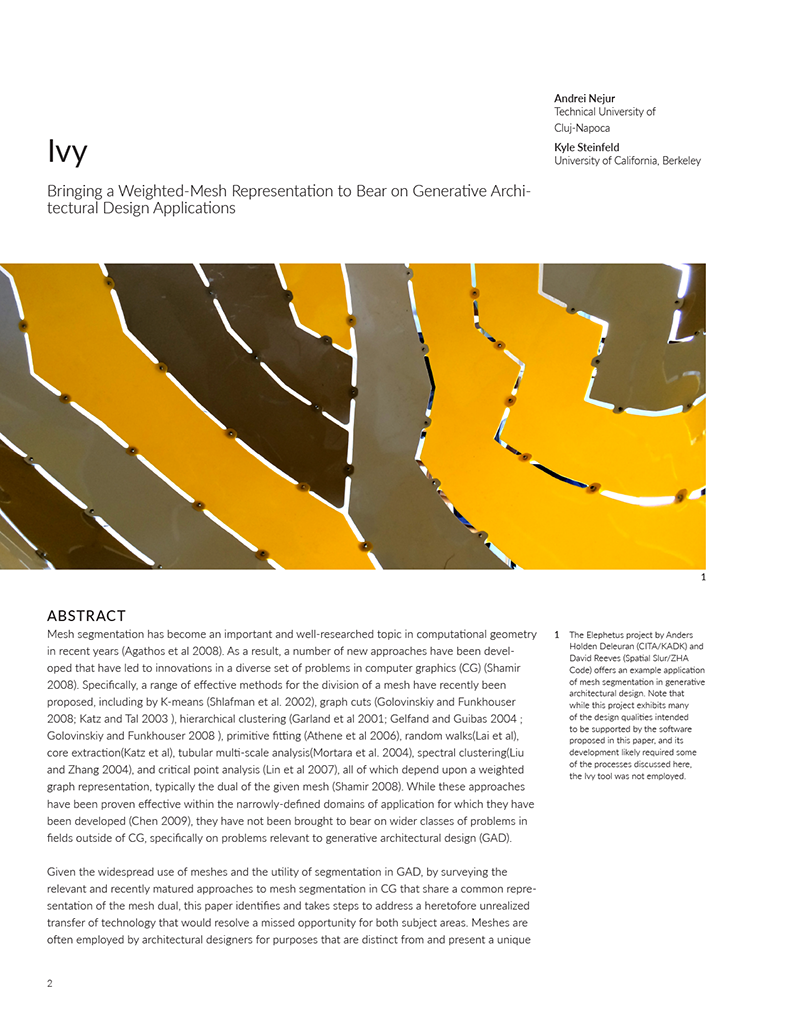Ivy - ACADIA 2016
Bringing a Weighted-Mesh Representation to Bear on Generative Architectural Design Applications
Andrei Nejur & Kyle Steinfeld
Given the widespread use of meshes and the utility of segmentation in generative architectural design, by surveying the relevant and recently matured approaches to mesh segmentation in CG that share a common representation of the mesh dual, this paper identifies and takes steps to address a heretofore unrealized transfer of technology that would resolve a missed opportunity for both subject areas.

Mesh segmentation has become an important and well-researched topic in computational geometry in recent years (Agathos et al. 2008). As a result, a number of new approaches have been developed that have led to innovations in a diverse set of problems in computer graphics (CG) (Sharmir 2008). Specifically, a range of effective methods for the division of a mesh have recently been proposed, including by K-means (Shlafman et al. 2002), graph cuts (Golovinskiy and Funkhouser 2008; Katz and Tal 2003), hierarchical clustering (Garland et al. 2001; Gelfand and Guibas 2004; Golovinskiy and Funkhouser 2008), primitive fitting (Athene et al. 2004), random walks (Lai et al.), core extraction (Katz et al.) tubular multi-scale analysis (Mortara et al. 2004), spectral clustering (Liu and Zhang 2004), and critical point analysis (Lin et al. 20070, all of which depend upon a weighted graph representation, typically the dual of a given mesh (Sharmir 2008). While these approaches have been proven effective within the narrowly defined domains of application for which they have been developed (Chen 2009), they have not been brought to bear on wider classes of problems in fields outside of CG, specifically on problems relevant to generative architectural design.
Meshes are often employed by architectural designers for purposes that are distinct from and present a unique set of requirements in relation to similar applications that have enjoyed more focused study in computer science. This paper presents a survey of similar applications, including thin-sheet fabrication (Mitani and Suzuki 2004), rendering optimization (Garland et al. 2001), 3D mesh compression (Taubin et al. 1998), morphin (Shapira et al. 2008) and mesh simplification (Kalvin and Taylor 1996), and distinguish the requirements of these applications from those presented by GAD, including non-refinement in advance of the constraining of mesh geometry to planar-quad faces, and the ability to address a diversity of mesh features that may or may not be preserved. Following this survey of existing approaches and unmet needs, the authors assert that if a generalized framework for working with graph representations of meshes is developed, allowing for the interactive adjustment of edge weights, then the recent developments in mesh segmentation may be better brought to bear on GAD problems. This paper presents work toward the development of just such a framework, implemented as a plug-in for the visual programming environment Grasshopper.
Read the full paper here.